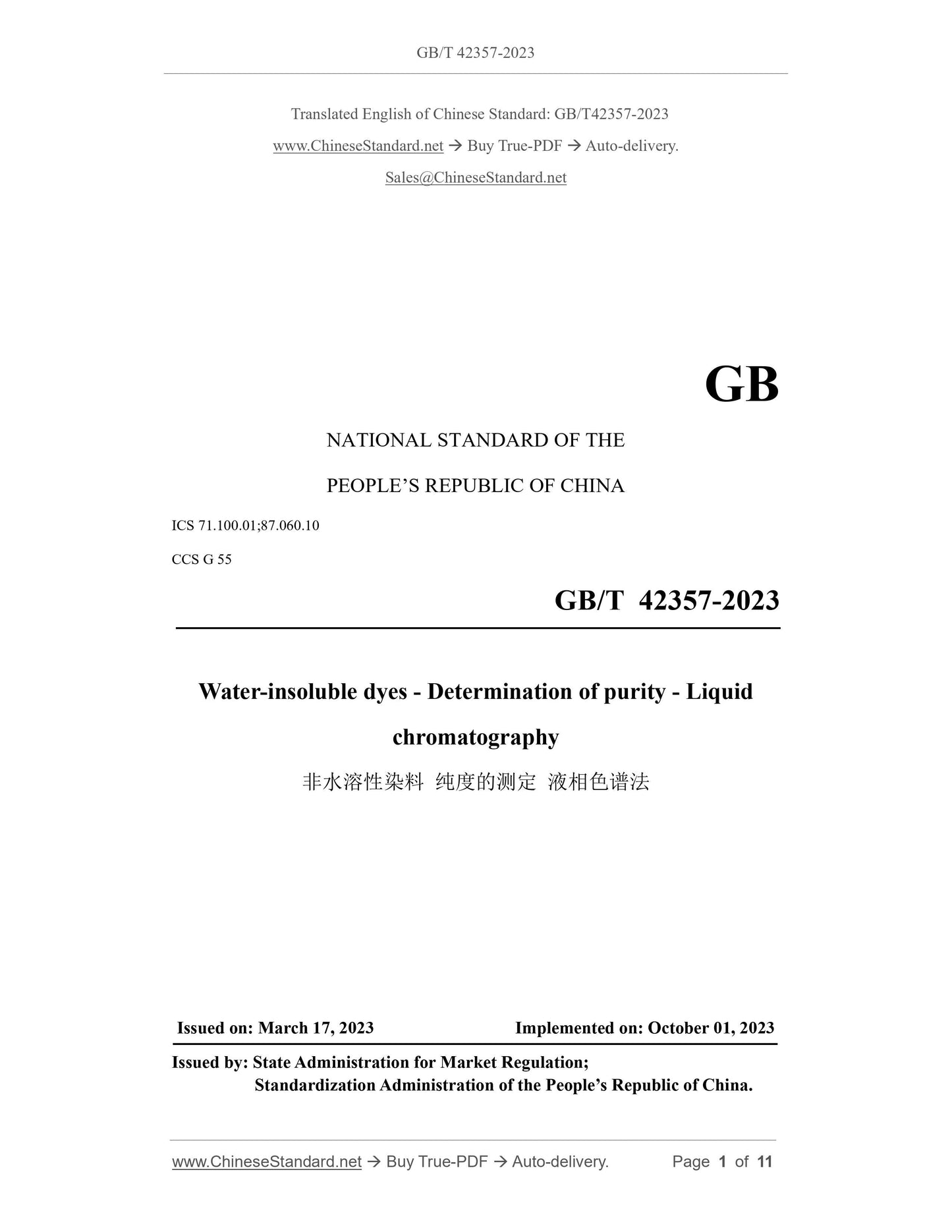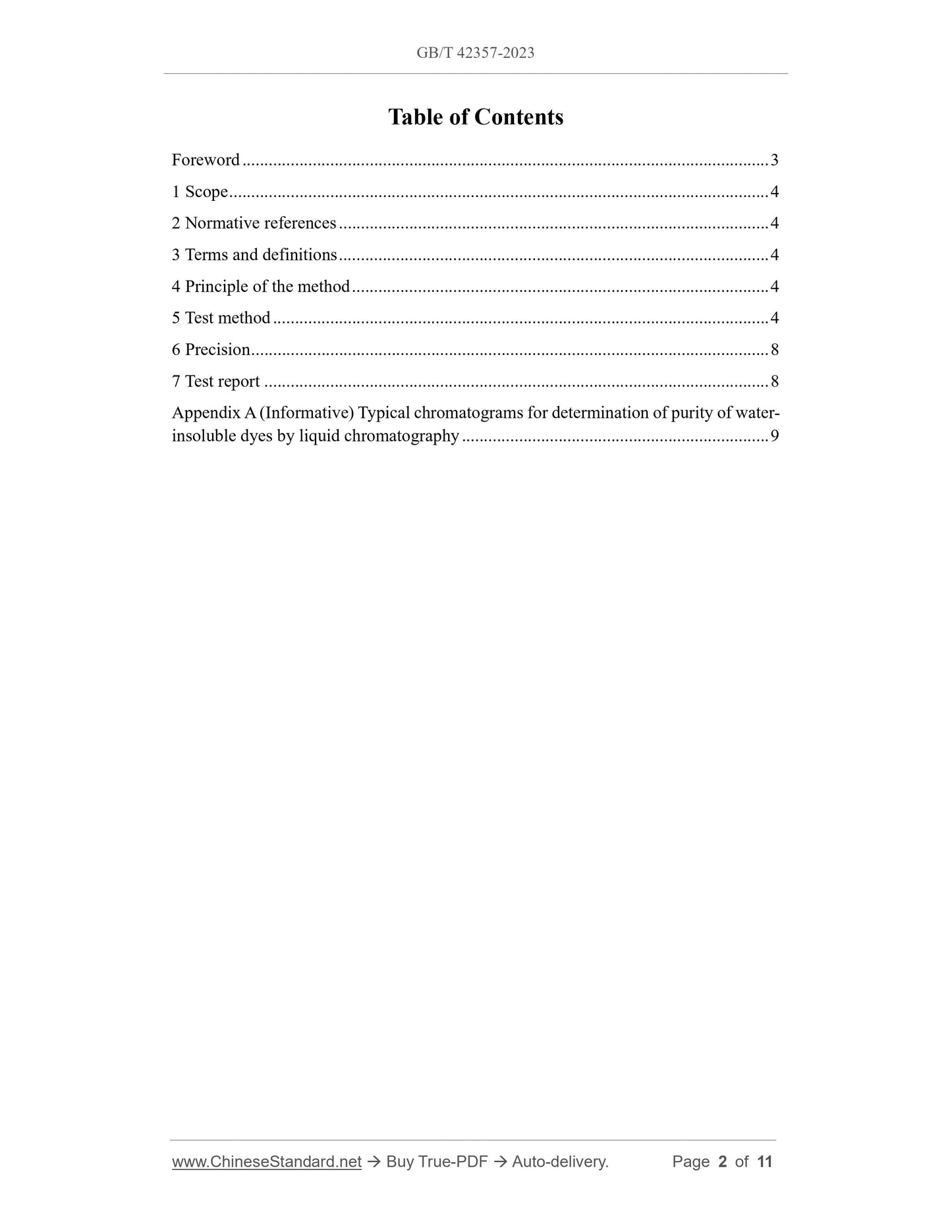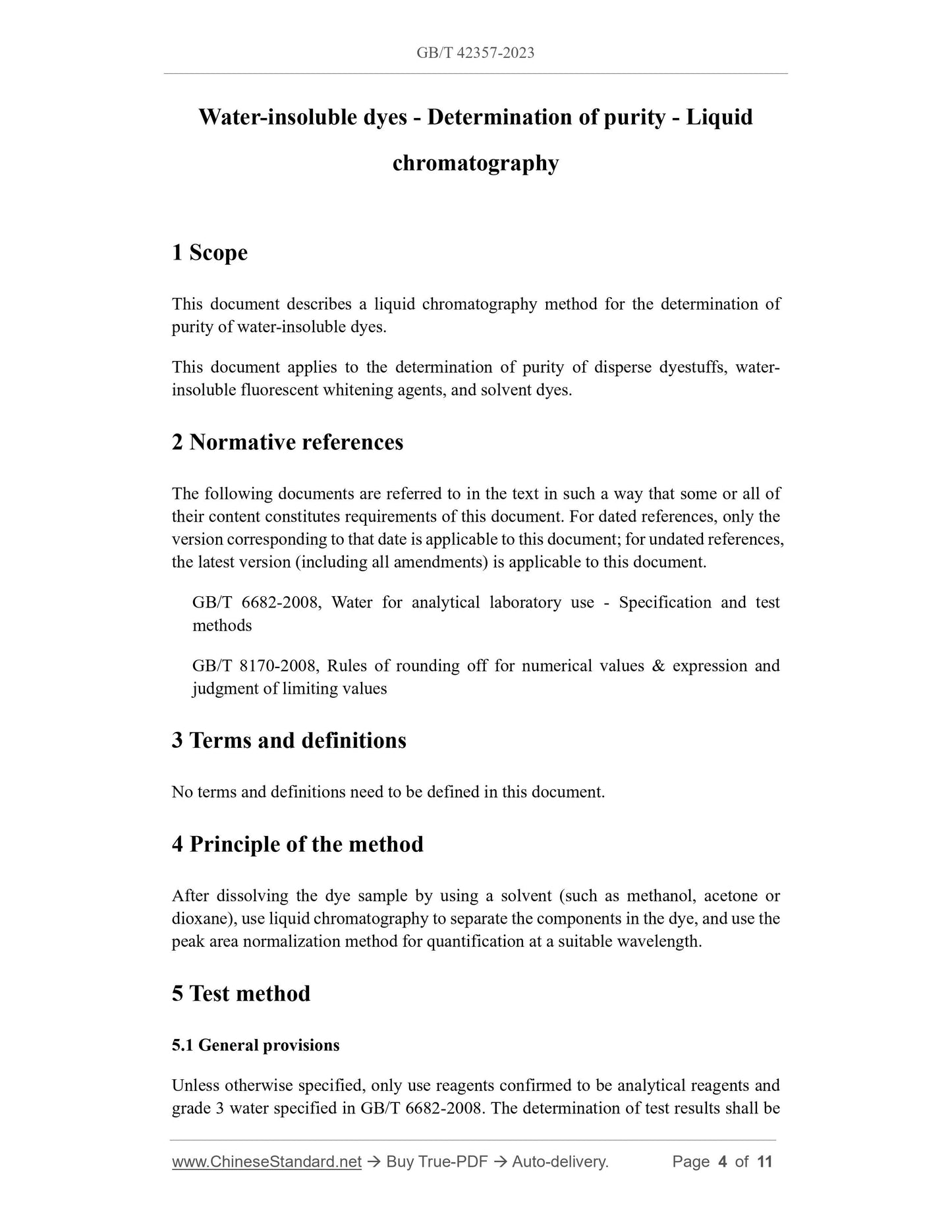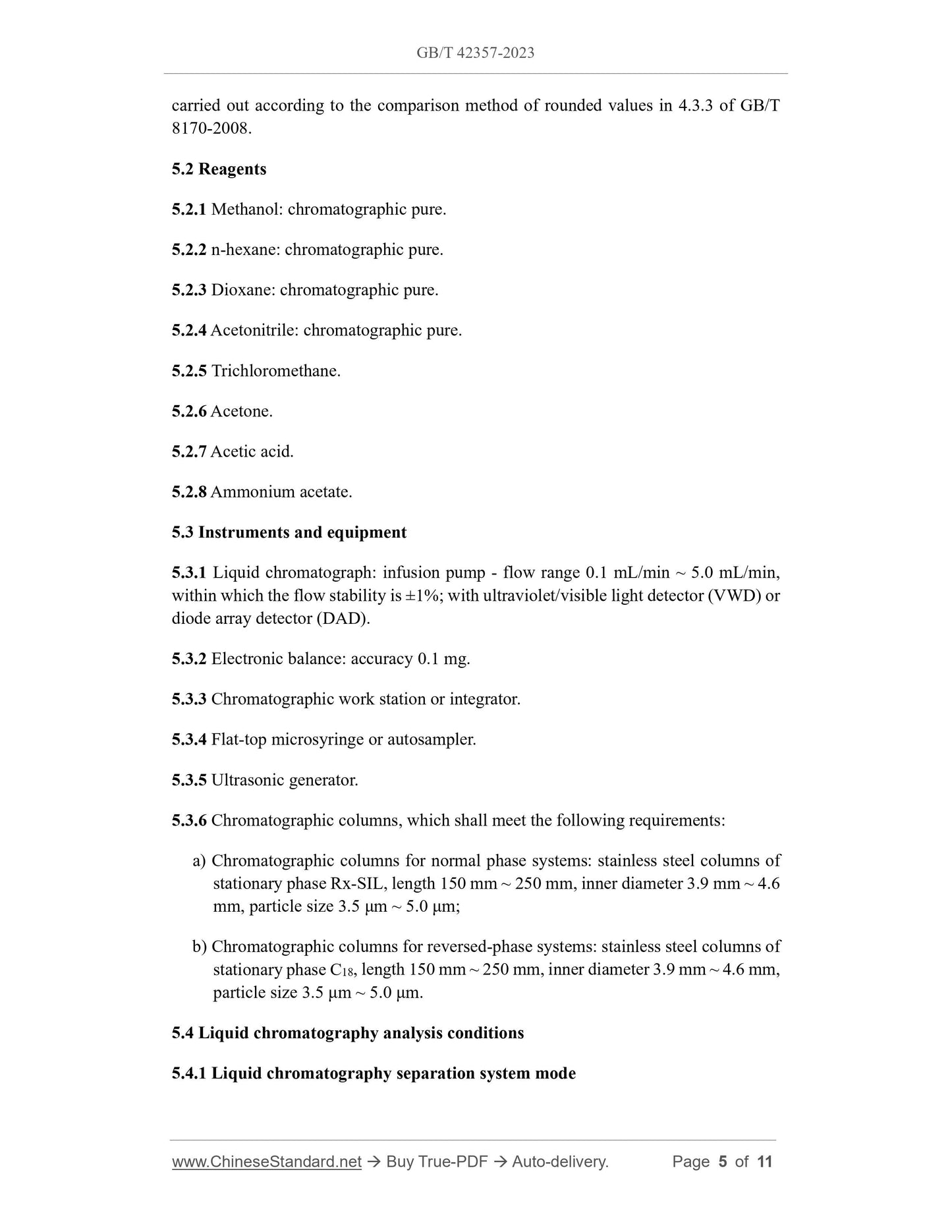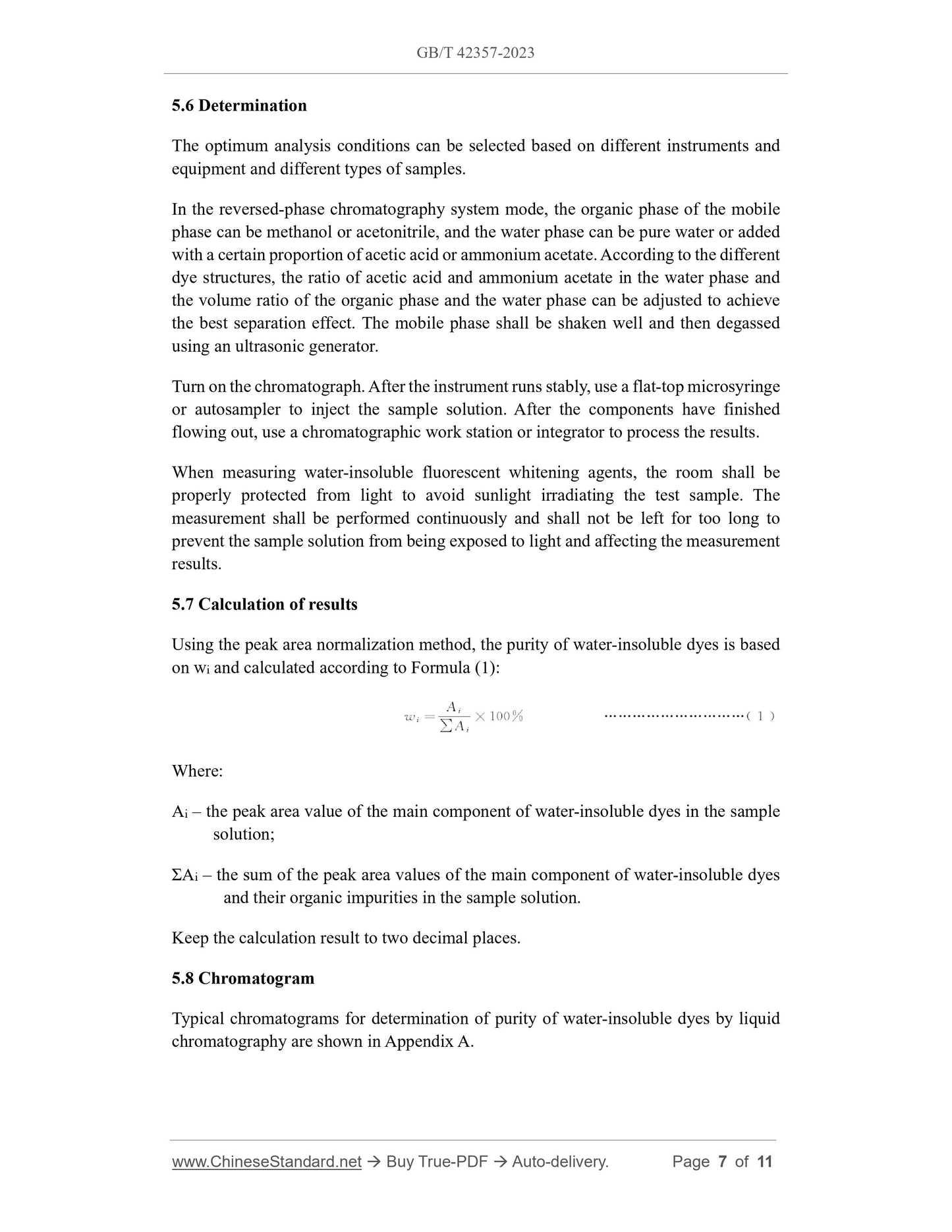1
/
of
5
PayPal, credit cards. Download editable-PDF and invoice in 1 second!
GB/T 42357-2023 English PDF (GBT42357-2023)
GB/T 42357-2023 English PDF (GBT42357-2023)
Regular price
$185.00 USD
Regular price
Sale price
$185.00 USD
Unit price
/
per
Shipping calculated at checkout.
Couldn't load pickup availability
Delivery: 3 seconds. Download true-PDF + Invoice.
Get QUOTATION in 1-minute: Click GB/T 42357-2023
Historical versions: GB/T 42357-2023
Preview True-PDF (Reload/Scroll if blank)
GB/T 42357-2023: Water-insoluble dyes -- Determination of purity -- Liquid chromatography
GB/T 42357-2023
GB
NATIONAL STANDARD OF THE
PEOPLE’S REPUBLIC OF CHINA
ICS 71.100.01;87.060.10
CCS G 55
Water-insoluble dyes - Determination of purity - Liquid
chromatography
ISSUED ON: MARCH 17, 2023
IMPLEMENTED ON: OCTOBER 01, 2023
Issued by: State Administration for Market Regulation;
Standardization Administration of the People’s Republic of China.
Table of Contents
Foreword ... 3
1 Scope ... 4
2 Normative references ... 4
3 Terms and definitions ... 4
4 Principle of the method ... 4
5 Test method ... 4
6 Precision ... 8
7 Test report ... 8
Appendix A (Informative) Typical chromatograms for determination of purity of water-
insoluble dyes by liquid chromatography ... 9
Water-insoluble dyes - Determination of purity - Liquid
chromatography
1 Scope
This document describes a liquid chromatography method for the determination of
purity of water-insoluble dyes.
This document applies to the determination of purity of disperse dyestuffs, water-
insoluble fluorescent whitening agents, and solvent dyes.
2 Normative references
The following documents are referred to in the text in such a way that some or all of
their content constitutes requirements of this document. For dated references, only the
version corresponding to that date is applicable to this document; for undated references,
the latest version (including all amendments) is applicable to this document.
GB/T 6682-2008, Water for analytical laboratory use - Specification and test
methods
GB/T 8170-2008, Rules of rounding off for numerical values and expression and
judgment of limiting values
3 Terms and definitions
No terms and definitions need to be defined in this document.
4 Principle of the method
After dissolving the dye sample by using a solvent (such as methanol, acetone or
dioxane), use liquid chromatography to separate the components in the dye, and use the
peak area normalization method for quantification at a suitable wavelength.
5 Test method
5.1 General provisions
Unless otherwise specified, only use reagents confirmed to be analytical reagents and
grade 3 water specified in GB/T 6682-2008. The determination of test results shall be
carried out according to the comparison method of rounded values in 4.3.3 of GB/T
8170-2008.
5.2 Reagents
5.2.1 Methanol: chromatographic pure.
5.2.2 n-hexane: chromatographic pure.
5.2.3 Dioxane: chromatographic pure.
5.2.4 Acetonitrile: chromatographic pure.
5.2.5 Trichloromethane.
5.2.6 Acetone.
5.2.7 Acetic acid.
5.2.8 Ammonium acetate.
5.3 Instruments and equipment
5.3.1 Liquid chromatograph: infusion pump - flow range 0.1 mL/min ~ 5.0 mL/min,
within which the flow stability is ±1%; with ultraviolet/visible light detector (VWD) or
diode array detector (DAD).
5.3.2 Electronic balance: accuracy 0.1 mg.
5.3.3 Chromatographic work station or integrator.
5.3.4 Flat-top microsyringe or autosampler.
5.3.5 Ultrasonic generator.
5.3.6 Chromatographic columns, which shall meet the following requirements:
a) Chromatographic columns for normal phase systems: stainless steel columns of
stationary phase Rx-SIL, length 150 mm ~ 250 mm, inner diameter 3.9 mm ~ 4.6
mm, particle size 3.5 μm ~ 5.0 μm;
b) Chromatographic columns for reversed-phase systems: stainless steel columns of
stationary phase C18, length 150 mm ~ 250 mm, inner diameter 3.9 mm ~ 4.6 mm,
particle size 3.5 μm ~ 5.0 μm.
5.4 Liquid chromatography analysis conditions
5.4.1 Liquid chromatography separation system mode
5.6 Determination
The optimum analysis conditions can be selected based on different instruments and
equipment and different types of samples.
In the reversed-phase chromatography system mode, the organic phase of the mobile
phase can be methanol or acetonitrile, and the water phase can be pure water or added
with a certain proportion of acetic acid or ammonium acetate. According to the different
dye structures, the ratio of acetic acid and ammonium acetate in the water phase and
the volume ratio of the organic phase and the water phase can be adjusted to achieve
the best separation effect. The mobile phase shall be shaken well and then degassed
using an ultrasonic generator.
Turn on the chromatograph. After the instrument runs stably, use a flat-top microsyringe
or autosampler to inject the sample solution. After the components have finished
flowing out, use a chromatographic work station or integrator to process the results.
When measuring water-insoluble fluorescent whitening agents, the room shall be
properly protected from light to avoid sunlight irradiating the test sample. The
measurement shall be performed continuously and shall not be left for too long to
prevent the sample solution from being exposed to light and affecting the measurement
results.
5.7 Calculation of results
Using the peak area normalization method, the purity of water-insoluble dyes is based
on wi and calculated according to Formula (1):
Where:
Ai – the peak area value of the main component of water-insoluble dyes in the sample
solution;
ΣAi – the sum of the peak area values of the main component of water-insoluble dyes
and their organic impurities in the sample solution.
Keep the calculation result to two decimal places.
5.8 Chromatogram
Typical chromatograms for determination of purity of water-insoluble dyes by liquid
chromatography are shown in Appendix A.
Get QUOTATION in 1-minute: Click GB/T 42357-2023
Historical versions: GB/T 42357-2023
Preview True-PDF (Reload/Scroll if blank)
GB/T 42357-2023: Water-insoluble dyes -- Determination of purity -- Liquid chromatography
GB/T 42357-2023
GB
NATIONAL STANDARD OF THE
PEOPLE’S REPUBLIC OF CHINA
ICS 71.100.01;87.060.10
CCS G 55
Water-insoluble dyes - Determination of purity - Liquid
chromatography
ISSUED ON: MARCH 17, 2023
IMPLEMENTED ON: OCTOBER 01, 2023
Issued by: State Administration for Market Regulation;
Standardization Administration of the People’s Republic of China.
Table of Contents
Foreword ... 3
1 Scope ... 4
2 Normative references ... 4
3 Terms and definitions ... 4
4 Principle of the method ... 4
5 Test method ... 4
6 Precision ... 8
7 Test report ... 8
Appendix A (Informative) Typical chromatograms for determination of purity of water-
insoluble dyes by liquid chromatography ... 9
Water-insoluble dyes - Determination of purity - Liquid
chromatography
1 Scope
This document describes a liquid chromatography method for the determination of
purity of water-insoluble dyes.
This document applies to the determination of purity of disperse dyestuffs, water-
insoluble fluorescent whitening agents, and solvent dyes.
2 Normative references
The following documents are referred to in the text in such a way that some or all of
their content constitutes requirements of this document. For dated references, only the
version corresponding to that date is applicable to this document; for undated references,
the latest version (including all amendments) is applicable to this document.
GB/T 6682-2008, Water for analytical laboratory use - Specification and test
methods
GB/T 8170-2008, Rules of rounding off for numerical values and expression and
judgment of limiting values
3 Terms and definitions
No terms and definitions need to be defined in this document.
4 Principle of the method
After dissolving the dye sample by using a solvent (such as methanol, acetone or
dioxane), use liquid chromatography to separate the components in the dye, and use the
peak area normalization method for quantification at a suitable wavelength.
5 Test method
5.1 General provisions
Unless otherwise specified, only use reagents confirmed to be analytical reagents and
grade 3 water specified in GB/T 6682-2008. The determination of test results shall be
carried out according to the comparison method of rounded values in 4.3.3 of GB/T
8170-2008.
5.2 Reagents
5.2.1 Methanol: chromatographic pure.
5.2.2 n-hexane: chromatographic pure.
5.2.3 Dioxane: chromatographic pure.
5.2.4 Acetonitrile: chromatographic pure.
5.2.5 Trichloromethane.
5.2.6 Acetone.
5.2.7 Acetic acid.
5.2.8 Ammonium acetate.
5.3 Instruments and equipment
5.3.1 Liquid chromatograph: infusion pump - flow range 0.1 mL/min ~ 5.0 mL/min,
within which the flow stability is ±1%; with ultraviolet/visible light detector (VWD) or
diode array detector (DAD).
5.3.2 Electronic balance: accuracy 0.1 mg.
5.3.3 Chromatographic work station or integrator.
5.3.4 Flat-top microsyringe or autosampler.
5.3.5 Ultrasonic generator.
5.3.6 Chromatographic columns, which shall meet the following requirements:
a) Chromatographic columns for normal phase systems: stainless steel columns of
stationary phase Rx-SIL, length 150 mm ~ 250 mm, inner diameter 3.9 mm ~ 4.6
mm, particle size 3.5 μm ~ 5.0 μm;
b) Chromatographic columns for reversed-phase systems: stainless steel columns of
stationary phase C18, length 150 mm ~ 250 mm, inner diameter 3.9 mm ~ 4.6 mm,
particle size 3.5 μm ~ 5.0 μm.
5.4 Liquid chromatography analysis conditions
5.4.1 Liquid chromatography separation system mode
5.6 Determination
The optimum analysis conditions can be selected based on different instruments and
equipment and different types of samples.
In the reversed-phase chromatography system mode, the organic phase of the mobile
phase can be methanol or acetonitrile, and the water phase can be pure water or added
with a certain proportion of acetic acid or ammonium acetate. According to the different
dye structures, the ratio of acetic acid and ammonium acetate in the water phase and
the volume ratio of the organic phase and the water phase can be adjusted to achieve
the best separation effect. The mobile phase shall be shaken well and then degassed
using an ultrasonic generator.
Turn on the chromatograph. After the instrument runs stably, use a flat-top microsyringe
or autosampler to inject the sample solution. After the components have finished
flowing out, use a chromatographic work station or integrator to process the results.
When measuring water-insoluble fluorescent whitening agents, the room shall be
properly protected from light to avoid sunlight irradiating the test sample. The
measurement shall be performed continuously and shall not be left for too long to
prevent the sample solution from being exposed to light and affecting the measurement
results.
5.7 Calculation of results
Using the peak area normalization method, the purity of water-insoluble dyes is based
on wi and calculated according to Formula (1):
Where:
Ai – the peak area value of the main component of water-insoluble dyes in the sample
solution;
ΣAi – the sum of the peak area values of the main component of water-insoluble dyes
and their organic impurities in the sample solution.
Keep the calculation result to two decimal places.
5.8 Chromatogram
Typical chromatograms for determination of purity of water-insoluble dyes by liquid
chromatography are shown in Appendix A.
Share
